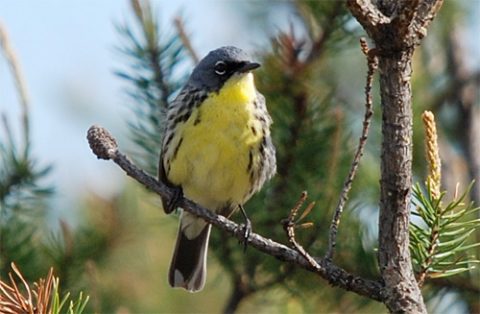Kirtland’s Warbler Delisted After 47 Years of Conservation Work
By Marc Devokaitis
January 9, 2020
From the Winter 2020 issue of Living Bird magazine. Subscribe now.
On October 8, 2019, the U.S. Fish and Wildlife Service announced that the Kirtland’s Warbler—one of the charter members of the Endangered Species Act of 1973—had completed its population recovery.
“The effort to recover the Kirtland’s Warbler is a shining example of what it takes to save imperiled species,” said Margaret Everson, principal deputy director of the U.S. Fish and Wildlife Service, in a statement about the warbler’s removal from the endangered species list.
Over the past five decades, the Kirtland’s Warbler population has skyrocketed from a low of fewer than 200 breeding pairs to around 2,300 pairs today—more than double the USFWS’s recovery goal. The recovery was fueled mostly by a two-pronged strategy of controlling the Brown-headed Cowbird population in Michigan where Kirtland’s Warblers breed (cowbirds are nest parasites that lay eggs in the warblers’ nests) and restoring the species’s favored jack-pine forest breeding habitat. (See Jack Pine Juggernauts: What Will Happen To Kirtland’s Warblers After Delisting?, Summer 2017).
“The delisting of the Kirtland’s Warbler is cause for celebration and proof that the Endangered Species Act works,” said Shawn Graff, vice president of American Bird Conservancy’s Great Lakes program. “But this warbler is still among the rarest, most range-restricted migratory birds in North America. It is conservation reliant, meaning that continued management efforts are imperative for the population to hold its ground.”
While the delisting is indeed happy news, it carries undertones of uncertainty because it means the loss of dedicated funding from the USFWS for conservation management. But according to Nathan Cooper, a postdoctoral fellow at the Smithsonian Migratory Bird Center who studies these birds, “most of the ESA money each year went toward cowbird management.” And that may no longer be needed.
In July, the Journal of Wildlife Management published research by Cooper that showed cowbirds parasitized less than 1% of Kirtland’s Warbler nests after cowbird traps had been recently removed. It seems the Kirtland’s Warbler population is strong enough now to tolerate cowbirds. “We’re still working out what parasitism rates the Kirtland’s population can withstand,” Cooper says, “but it’s safe to say 1 to 2% is fine.”
The real key to keeping the Kirtland’s Warbler population healthy, says Cooper, will be the continuation of forest management to create and sustain the young jack pine habitat where the birds nest. As a condition for the warbler’s delisting, the USFWS, U.S. Forest Service, and the Michigan Department of Natural Resources signed a memorandum of understanding that the agencies will continue habitat management at sufficient levels to ensure a continued stable Kirtland’s Warbler population. Keith Kintigh, a forest conservation specialist with the Michigan DNR, says his agency will plant 1.8 million jack pine seedlings per year going forward to help maintain the 38,000 acres of suitable jack-pine habitat needed to keep the warbler population above the 1,000-breeding-pair threshold for recovered status.
More on Kirtland's Warbler
“It’s a core responsibility of MDNR to regenerate forests after harvest, so we are obligated to find a way to fund this work,” says Kintigh. “[The tree planting] will continue to be paid for by a combination of grants and…state funds.”
Some of those grants could come from a newly created Kirtland’s Warbler Fund that American Bird Conservancy set up to raise private resources for maintaining conservation support for the species in the future. The fund is being managed to generate sustainable revenue for research and habitat conservation from the Kirtland’s Warbler’s breeding grounds in and around Michigan to its wintering grounds in the Bahamas.
In its final Kirtland’s Warbler delisting rule, the USFWS considered the impact of hurricanes in the Bahamas, such as 2019’s devastating Hurricane Dorian. But while the islands of Abaco and Grand Bahama took a direct hit from Dorian in August, the islands to the south were mostly spared—including Eleuthera, Cat, Long, and San Salvador Islands, where the largest known populations of Kirtland’s Warblers overwinter.
All About Birds
is a free resource
Available for everyone,
funded by donors like you
American Kestrel by Blair Dudeck / Macaulay Library







